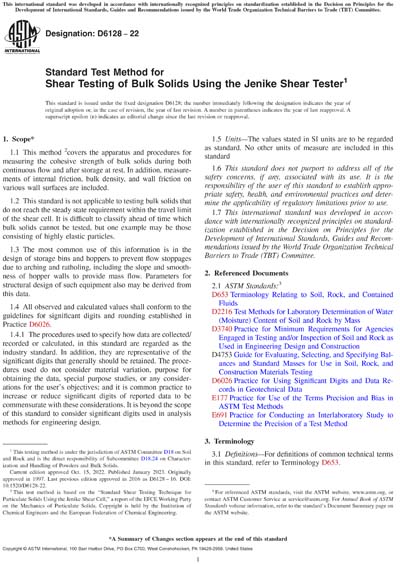Most recent
ASTM D6128-22
Standard Test Method for Shear Testing of Bulk Solids Using the Jenike Shear Tester
1.1This method 2covers the apparatus and procedures for measuring the cohesive strength of bulk solids during both continuous flow and after storage at rest. In addition, measurements of internal friction, bulk density, and wall friction on various wall surfaces are included.
1.2This standard is not applicable to testing bulk solids that do not reach the steady state requirement within the travel limit of the shear cell. It is difficult to classify ahead of time which bulk solids cannot be tested, but one example may be those consisting of highly elastic particles.
1.3The most common use of this information is in the design of storage bins and hoppers to prevent flow stoppages due to arching and ratholing, including the slope and smoothness of hopper walls to provide mass flow. Parameters for structural design of such equipment also may be derived from this data.
1.4All observed and calculated values shall conform to the guidelines for significant digits and rounding established in Practice D6026.
1.4.1The procedures used to specify how data are collected/recorded or calculated, in this standard are regarded as the industry standard. In addition, they are representative of the significant digits that generally should be retained. The procedures used do not consider material variation, purpose for obtaining the data, special purpose studies, or any considerations for the user's objectives; and it is common practice to increase or reduce significant digits of reported data to be commensurate with these considerations. It is beyond the scope of this standard to consider significant digits used in analysis methods for engineering design.
1.5Units - The values stated in SI units are to be regarded as standard. No other units of measure are included in this standard
1.6This standard does not purport to address all of the safety concerns, if any, associated with its use. It is the responsibility of the user of this standard to establish appropriate safety, health, and environmental practices and determine the applicability of regulatory limitations prior to use.
1.7This international standard was developed in accordance with internationally recognized principles on standardization established in the Decision on Principles for the Development of International Standards, Guides and Recommendations issued by the World Trade Organization Technical Barriers to Trade (TBT) Committee.
Content Provider
ASTM International [astm]






